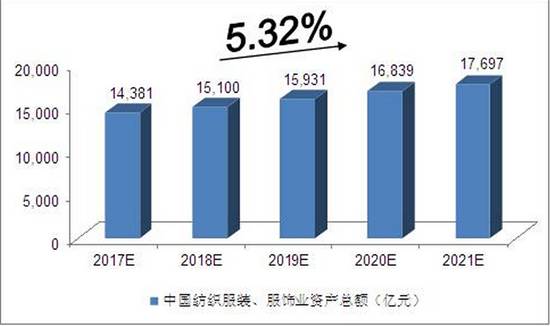(A) of the industry development factors
1, favorable factors
(1) policy benefits
September 2016, the Ministry of Industry and Information Technology issued a "textile industry development plan (2016-2020)."
"Plan" to improve the development of quality and efficiency as the center, to promote the structural reform of the supply side of the main line to increase the variety, quality, a brand "three products" strategy as the focus, enhance industrial innovation, optimize the industrial structure , To promote intelligent manufacturing and green manufacturing, the formation of the development of new energy, to create new competitive advantage, to promote the industry towards high-end, initially built textile power. "Plan" put forward industry growth targets, "13th Five-Year Plan" period, the above-scale textile enterprises in the average annual growth rate of industrial added value remained at 6% -7%; textile and apparel exports accounted for global market share remained stable; textile industry growth mode from Scale speed type to quality and efficiency.
(2) steady growth in consumption
Domestic demand expansion and consumption upgrade will be the biggest driving force of the development of China's textile industry, urban and rural incomes growth, new urbanization and the implementation of two child policy, such as the full implementation of the dividend and reform bonus stack will promote the upgrading of textile consumption growth is expected to domestic clothing And household consumption spending average annual growth of about 8%. With the domestic infrastructure construction, environmental management, health care and other aspects of steady growth in investment, industrial textile fiber consumption will continue to maintain rapid growth.
(3) the Internet +
Investment adviser in the "2017-2021 China's apparel industry investment analysis and forecast report," said the textile industry and information technology, the depth of the Internet integration for innovation and development provides a broad space, but also the traditional mode of production and management challenges.
① Internet finance (including supply chain finance). Jixin Silk based on China's cocoon and silk market to build supply chain finance; seven wolves Group is still participating in electrical products business, to create a set of supporting services to create a small version of the "Golden Garments" + Supply chain finance based on the P2P model; shares of shares "micro-selling", to create online auction + supply chain financial model; Hailan House has formed suppliers, including health ecosphere, with supply chain finance Foundation.
② cross-border electricity providers. Cross-border pants industry to create cross-platform business alliance; Semir clothing cross-border acquisition of South Korean business platform; Smith Barney costumes to create "a fan" APP gathered the world fashion brand.
③ industrial 4.0. Good news birds, nine animal husbandry Wang, Younger, Hailan home, Aokang International, Lutai were introduced clothing, shoes and other custom business.
2, unfavorable factors
(1) transfer to Southeast Asia
In recent years, due to the rising labor costs in China, the advantages of low labor costs in Southeast Asia, coupled with the implementation of the region's tax and policy concessions, many textile and garment enterprises have invested in Southeast Asia. From the export point of view, the lack of bargaining power of domestic enterprises, the production of value-added products is not high, as competition intensifies, fewer and fewer orders, prices are getting lower and lower overseas orders slowly to Southeast Asia.
(2) environmental issues
The textile industry has been a high energy consumption, high pollution industries. In recent years, the "atmosphere of ten", "water ten", "soil ten" have been introduced, the environmental protection department investigation and punishment also began to increase, textile enterprises in environmental protection pressure. "Textile Industry Development Plan (2016-2020)", proposed to form the textile industry green manufacturing system, clean production technology is widely used, by 2020, the textile unit of industrial added value energy consumption decreased by 18%, unit of industrial added value of water Down 23%, the total discharge of major pollutants decreased by 10%. The increase in environmental spending is bound to compress the profits of the textile industry.
(3) lack of market research
The lack of effective market research and research, the lack of effective guidance, the expansion of the scale of production of social clothing mostly with a certain blindness and short-sightedness. Some new production capacity is concentrated in the relatively high profit margins of conventional products, such as down jackets, men's suits, shirts and other products. Men's production has gradually become the pattern of well-known brands seeking "serialization", "hierarchical" trend is obvious in the expansion of economies of scale, marketing strategies and marketing methods on the brains, but few companies make great efforts in-depth market research, Innovation ability, improve the quality of enterprise personnel, strengthen enterprise management, research clothing plate design and related basic research and other aspects of efforts. In fact, these are shaken the foundation of enterprise development, hinder enterprises and products to increase value-added, continued to expand and maintain market share of the key factors, so there will be surplus clothing for the one hand, prices plummeted, the other consumers Can not buy a bed of roses clothing situation.
(B) the industry's total assets forecast
In 2015, the total assets of China's textile and apparel industry reached RMB1,303.17 billion, an increase of 6.21%. In September 2016, the total assets reached RMB1,300.41 billion, an increase of 4.69% over the same period of last year. Investment adviser in the "2017-2021 China's apparel industry investment analysis and forecast report" is expected in 2017, China's textile and apparel industry, the total assets will reach 1.4381 trillion yuan, the next five years (2017-2021) average annual Compound growth rate of about 5.32% in 2021, China's textile and apparel industry, the total assets will reach 1.769 billion yuan.







